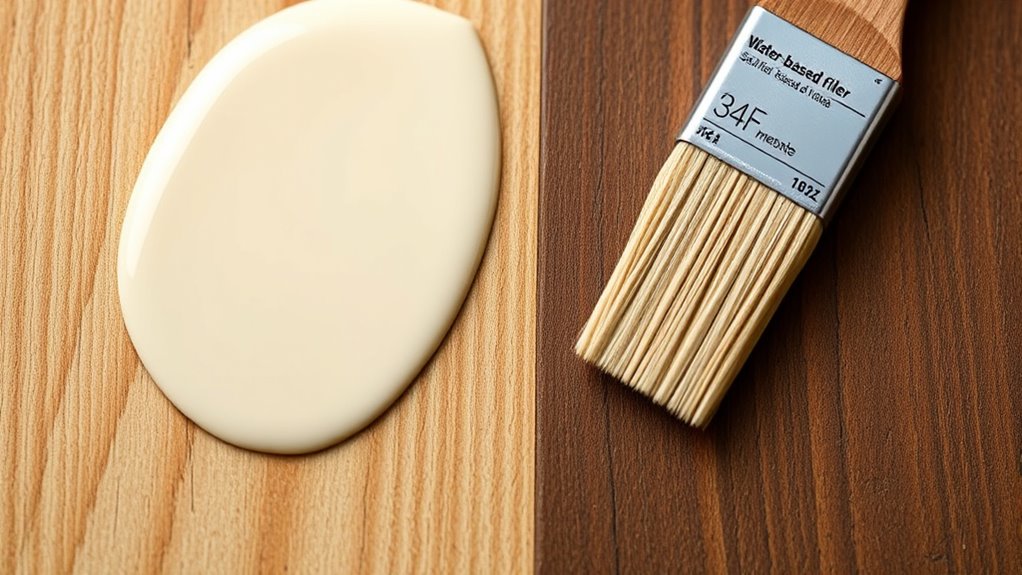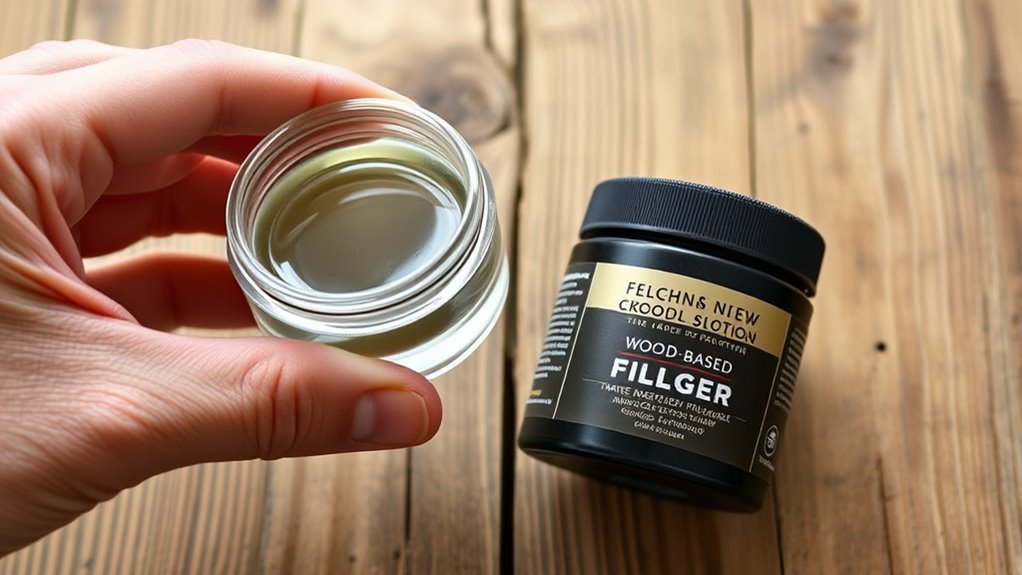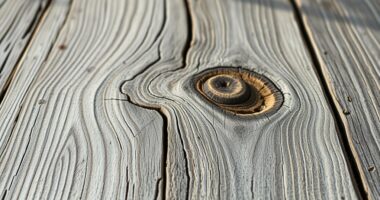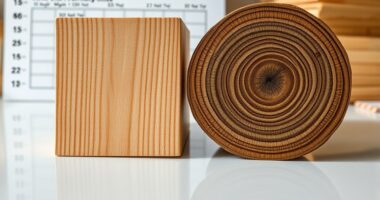When choosing between water-based and solvent-based wood fillers, consider your project’s environment and durability needs. Water-based fillers are easy to apply, eco-friendly, and ideal for indoor projects, but may crack outdoors in humid conditions. Solvent-based fillers are more durable and weather-resistant, perfect for outdoor use, but require good ventilation and handling. To make the best choice, weigh these factors carefully—more details will help you decide which fits your project best.
Key Takeaways
- Choose water-based fillers for indoor projects, eco-friendliness, and easy cleanup; opt for solvent-based for outdoor durability and weather resistance.
- Water-based fillers dry quickly, are user-friendly, and ideal for small repairs, while solvent-based fillers offer superior long-term strength.
- Consider environmental impact: water-based options have lower VOCs and are safer for indoor use, whereas solvent-based fillers have higher VOCs.
- For outdoor or moisture-prone applications, solvent-based fillers provide better resistance and longevity.
- Balance project needs: use water-based for ease and eco-friendliness, and solvent-based for durability and weather resistance.

When choosing a wood filler, understanding the differences between water-based and solvent-based options is essential for achieving the best results. Your decision impacts not only how well the repair holds but also how easy it is to work with and the environmental footprint of your project. Water-based fillers are known for their application versatility. They are easy to apply, clean up with water, and dry quickly, making them suitable for a wide range of indoor projects. Whether you’re filling small nail holes or larger cracks, water-based fillers tend to be user-friendly, especially for beginners. They also tend to sand smoothly once dry, providing a neat finish without much effort. However, their application versatility is somewhat limited in outdoor settings or areas exposed to moisture, as they are more prone to shrinking or cracking when exposed to humidity or temperature fluctuations. Additionally, their ability to support long-term durability is generally less than that of solvent-based fillers, especially in challenging environments.
On the other hand, solvent-based fillers excel in durability and weather resistance, making them an excellent choice for outdoor applications or surfaces that require long-lasting repairs. They are more resistant to moisture, temperature changes, and wear, which means they can handle harsh conditions better than water-based options. If you’re working on a deck, outdoor furniture, or any exterior wood surface, solvent-based fillers are often the better choice for ensuring longevity. Nevertheless, when considering environmental impact, solvent-based fillers pose more concerns. They contain volatile organic compounds (VOCs), which can contribute to air pollution and pose health risks during application. If you’re environmentally conscious or working in a space with poor ventilation, this factor might sway you toward water-based alternatives.
While water-based fillers are generally considered more eco-friendly due to their low VOC content, they might not be suitable for all projects, especially those requiring maximum durability. Conversely, solvent-based fillers, while more durable, demand careful handling, proper disposal, and good ventilation to minimize health and environmental risks. Ultimately, your choice hinges on balancing application versatility with environmental impact. If you’re tackling an indoor project where ease of use and eco-friendliness matter most, water-based fillers are a smart pick. For outdoor or high-stress applications where longevity counts more than environmental concerns, solvent-based fillers could be the better option. Knowing these differences helps you make an informed decision that aligns with your project needs, safety considerations, and environmental values.
Frequently Asked Questions
How Long Does Each Type of Filler Typically Last?
You wonder how long each filler lasts. Water-based fillers usually have a shorter durability compared to solvent-based options, which can last for years if properly applied. Although solvent-based fillers tend to cost more upfront, their longer-lasting durability offers better value over time. Your choice depends on your project needs; if you want quick, easy repairs, water-based works fine, but for long-term results, solvent-based is often the better option.
Are There Environmental Concerns With Solvent-Based Fillers?
Did you know solvent-based fillers can emit VOCs, contributing to air pollution? Yes, there are environmental concerns with these products. They often have higher VOC emissions, which impact air quality and contribute to smog formation. Using solvent-based fillers may pose health risks during application and disposal. If you’re eco-conscious, you might prefer water-based options, as they generally have a lower environmental impact and produce fewer VOC emissions.
Can Water-Based Fillers Be Used Outdoors Effectively?
You ask if water-based fillers work outdoors. They can be effective if you consider weather resistance, as some formulas resist moisture better than others. Keep in mind that water-based fillers often excel in color matching, blending seamlessly into your wood. However, for long-term outdoor use, choose a high-quality, weather-resistant option and apply a protective finish to guarantee durability against the elements.
Is Special Equipment Needed for Applying Solvent-Based Fillers?
When applying solvent-based fillers, you’ll need special application tools like brushes or spatulas designed for chemicals. It’s also essential to follow safety precautions, such as working in well-ventilated areas and wearing gloves and masks to avoid fumes and skin contact. These steps guarantee safe handling and a smooth finish. Remember, proper tools and safety measures make the application process easier and safer for you.
How Do I Remove Excess or Dried Filler Easily?
Imagine the frustration of dried, stubborn filler marring your project. To remove excess or dried filler, start with cleanup tips: gently scrape with a putty knife or sandpaper, applying light pressure. For fresh application, use damp cloths to wipe away excess. Proper application techniques matter—work swiftly before it dries. Patience and a steady hand make cleanup easier, turning what feels like a mess into a smooth, flawless finish.
Conclusion
Choosing between water-based and solvent-based wood filler is like selecting a path through different forests—you’ll want to evaluate your environment and needs. Water-based fillers are your gentle streams, blending seamlessly and nurturing your project’s future. Solvent-based fillers are the rugged mountains, offering strength and durability. Whichever path you take, remember that your choice shapes the story of your woodwork—it’s the symbol of your craftsmanship, reflecting your care and vision for lasting beauty.









